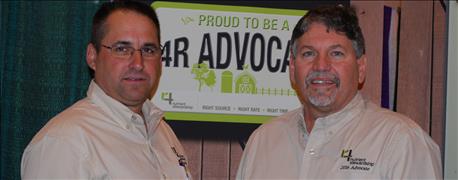
Split nitrogen applications? Check. Cover crops? Check. Buffer strips and grass waterways? Check, check. There aren’t many best management practices that 4R Advocate and Shipman farmer Tom Connors hasn’t implemented on his farm.
“Whether it’s reduced phosphorus rates, variable rate nitrogen, conservation practices, CSP programs, all those things, we’ve been doing them for 20 years,” says Connors. “Yes, nutrient management may be a hot topic right now, but for us, it’s just another day of what we do.”

PRECISION MANAGEMENT: Tom Connors, left, and Regan Wear believe the 4Rs, looking at different multipliers working together, make a difference.
Connors explains one nitrogen management strategy is variable rate applications based on organic matter. Some of his highest yielding fields had the lowest rates of applied nitrogen. Connors notes that with low commodity prices, the approach towards inputs will change. “For the past few years, everyone was throwing the kitchen sink at everything. That will come back down to people looking to be more efficient with their dollar.”
Farmers will also work on reducing nutrient loss.
Connors is on his third year planting cereal rye, tillage radishes and oat cover crops as part of the Conservation Stewardship Program. “I’m still on my learning curve with cover crops,” Connors admits. Establishing a solid stand before the first frost is challenging for him. This season, sowing cover crops into V6 corn versus flying them in may be an option.
Connors’ drive to constantly evolve his operation is what jumped out at his agronomist, CHS crop advisor Regan Wear.
“Tommy did a really good job identifying early in precision ag that data was going to be important and was really precise about getting the data right,” Wear says. “He wanted to make sure the yield monitors on the combines were calibrated correctly and that he was collecting planting data and soil sampling precisely.”
Connors offers the key to success with precision data. “You�’ve got to do the little things right,” Connors says. A lesson he learned after his dad turned technology over to him at an early age. “The soil samples have to be pulled from the exact same zones,” Connors explains. “Ours have been the same since 1995.” The same accuracy applies to calibrating yield monitors and planters.
Connors uses all that precise data to create a detailed plan for every single field. Hybrid, seeding rate, Bt, non GMO, it’s all mapped out. Connors creates his ‘bible’ for the year. And everyone, from his agronomist to all of his sales reps, agrees on the ‘bible’.
Sounds like an awful lot of work, right? Connors says it’s worth it. He is constantly overlaying the data to see what strategies are making a difference. Over time, his corn and soybean yields have increased 5% every year.
Connors also has a little to say on his 4R advocacy role. “I’m not a guy looking for publicity, these are just some of the practices that we do.”
Did you catch that? “Some of the practices that we do.” Connors may try to avoid the limelight, but his approach to farming is award worthy.
About the Author(s)
You May Also Like




